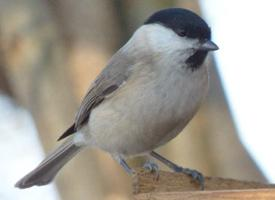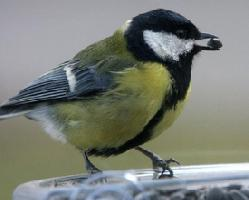
Weights and measures
| Length | from 11 to 12 cm |
|---|---|
| Weight | from 9 to 12 g |
| Wingspan | from 18 to 19 cm |
Animal description
The Marsh Tit (Poecile palustris) is a small, enchanting passerine bird that graces the woodlands, gardens, and marshes across Europe and parts of Asia with its presence. This delightful species is a member of the tit family, Paridae, known for their intelligence, vibrant social behavior, and striking plumage. Despite its name suggesting a preference for marshy areas, the Marsh Tit is often found in a variety of wooded habitats, including deciduous forests, mixed woodlands, and even in well-vegetated urban areas.Characterized by its compact size, the Marsh Tit measures about 11.5 to 13.5 cm in length, with a wingspan that ranges from 17 to 20 cm, and weighs approximately 10 to 12 grams. It possesses a sleek, glossy black cap and bib, which contrast sharply with its white cheeks and underparts. The upper parts are a soft, dusky brown, blending seamlessly into its surroundings. A distinguishing feature of the Marsh Tit is its tiny, yet stout bill, adept at cracking seeds and probing bark for insects and spiders. Additionally, keen observers might note the presence of a small, white spot at the base of the upper beak, a subtle mark that helps differentiate it from the closely related Willow Tit.
The Marsh Tit exhibits remarkable adaptability in its foraging habits. It is often seen flitting through the lower branches of trees and shrubs, skillfully extracting food from crevices in the bark or leaf litter. In the colder months, it demonstrates an impressive memory by retrieving food from caches it has hidden away during more abundant times. Its diet is varied and includes seeds, insects, and spiders, showcasing the bird's opportunistic feeding strategy.
Breeding season heralds a flurry of activity for the Marsh Tit, beginning in early spring. The bird is monogamous, with pairs forming strong bonds. Nests are meticulously constructed in cavities, often in tree trunks or sometimes in wall crevices or nest boxes. The interior is lined with soft materials such as moss, hair, and feathers, creating a cozy environment for the laying of 6 to 9 white eggs, speckled with reddish spots. Both parents are involved in the incubation and feeding of the chicks, which fledge about 18 to 21 days after hatching.
The vocal repertoire of the Marsh Tit is diverse and includes a variety of calls and songs. Its most recognizable call is a sharp "pitchou" sound, which it uses to communicate with its mate or signal alarm. During the breeding season, the male's song is a melodious and repetitive sequence of notes, used to defend territory and attract a mate.
Despite facing challenges such as habitat loss and competition for nesting sites, the Marsh Tit has maintained a stable population in many parts of its range. However, in some areas, numbers have declined, highlighting the importance of conserving the natural woodlands and marshes that these birds call home. Observing a Marsh Tit in its natural habitat is a delightful experience, offering a glimpse into the complex behaviors and ecological roles of small passerine birds within their ecosystems.
Similar Animals
New photos of animals
Top 10 animals
- Dolphin gull (Leucophaeus scoresbii)
- Diana monkey (Cercopithecus diana)
- Moustached guenon (Cercopithecus cephus)
- Galápagos tortoise (Geochelone nigra complex)
- Japanese macaque (Macaca fuscata)
- Stone loach (Barbatula barbatula)
- Russian tortoise (Testudo horsfieldii)
- Greek tortoise (Testudo graeca)
- Common flying dragon (Draco volans)
- Vendace (Coregonus albula)


